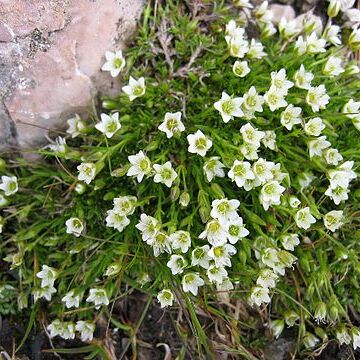Herbs, annual, winter annual, or perennial, sometimes mat-forming. Taproots filiform to stout and woody, perennial plants often with branched caudex or with rhizomes or trailing stems. Stems ascending to erect or prostrate, simple or branched, ± terete. Leaves mostly connate proximally, petiolate (M. cumberlandensis, M. godfreyi proximal leaves) or sessile; blade 1-3-veined, sometimes obscurely so, filiform-linear to subulate, lanceolate or oblanceolate, rarely to ovate, herbaceous to succulent, apex blunt, rounded, or obtuse to acute, acuminate, or spinescent. Inflorescences terminal, open or seldom congested cymes or flowers solitary and terminal or axillary, rarely absent; bracts paired, herbaceous or scarious, rarely absent (M. pusilla, M. rossii). Pedicels erect to arcuate-spreading, rarely reflexed (M. drummondii) in fruit. Flowers: perianth and androecium perigynous; hypanthium usually disc-, occasionally dish-or cup-shaped; sepals 5, distinct, green (herbaceous portion purple in M. arctica, M. macrocarpa, and M. rossii), linear, lanceolate, or oblong to elliptic, ovate, or broadly ovate, 1.5-6(-9) mm, margins herbaceous or silvery and scarious, apex rounded or obtuse to acute, acuminate, or spinescent, sometimes hooded; petals 5 or rarely absent, white, rarely pink (M. biflora) or lilac (M. marcescens), clawed (M. glabra, M. groenlandica) or not, blade apex entire, emarginate, or notched; nectaries 5, at base of filaments opposite sepals, sometimes prominent and 2-lobed; stamens 10 (8-10 in M. godfreyi), arising from hypanthium; filaments distinct; staminodes absent; styles 3 (to 4 in M. cumberlandensis, M. godfreyi), filiform, 0.6-2.5 mm, glabrous proximally; stigmas 3 (to 4 in M. cumberlandensis, M. godfreyi), linear along adaxial surface of styles, minutely papillate (30×). Capsules ovoid to broadly ellipsoid or rarely globose, opening by 3 incurved or erect to recurved valves; carpophore absent or sometimes present. Seeds 1-25, reddish brown to brown or black (or rarely yellowish or purplish brown), spherical or suborbiculate to reniform or obliquely triangular, plump or variously compressed, smooth, reticulate, tuberculate, muriculate-papillate, or rarely with long marginal papillae (M. macrocarpa), marginal wing absent (present in M. douglasii), appendage absent. x = 7, 9, 10, 12, 13, 14, 15, 23.
More
Annual or perennial herbs or even subshrubs, with simple or branched stems. Leaves very variable in shape and texture, often acicular, subulate, or setaceous and three-(up to seven-) nerved, exstipulate. Sepals free, 5 (rarely 4), spreading at anthesis. Petals 5 (rarely 4), or absent, when present generally quite entire or rarely emarginate, contracted to base into a very short claw. Stamens typically 10 but sometimes reduced in number, provided with glands at the base of the filaments. Ovary superior, rarely semi-inferior at anthesis, unilocular; styles usually 3. Capsule with the same number of valves as styles were present in the gynoecium, that is usually 3.
Annual to perennial herbs. Hairs glandular and/or eglandular, or 0. Lvs opposite, exstipulate, entire, narrow-lanceolate to linear-subulate. Infl. cymose, (1)-few-to many-flowered; bracts and sepals usually with scarious margins; epicalyx 0. Sepals 5, free. Petals 5, white, entire or slightly emarginate; coronal scales 0. Stamens 10 or fewer. Styles 3-(5). Fr. an oblong or narrowly ovoid capsule, often included in calyx, dehiscing by as many entire obtuse teeth as the styles; carpophore 0. Seeds (1)-many, smooth, tuberculate or fimbriate, not winged.
Herbs annual or perennial. Stems caespitose or solitary, prostrate; branches ascending or erect. Leaves linear, linear-subulate, or setaceous, 1-or 3-veined. Inflorescence cymose or flowers solitary. Sepals 5, 1-or 3-veined. Petals 5, white, rarely reddish, apex entire or emarginate. Stamens 10. Ovary 1-loculed; ovules numerous. Styles 3. Capsule narrowly ovoid or ovoid-cylindric, 3-valved. Seeds ovoid, reniform, or discoid; raphe sometimes tuberculate or fimbriate tuberculate.
Pending. See Adams (1996), Richardson (2016).

